Menu
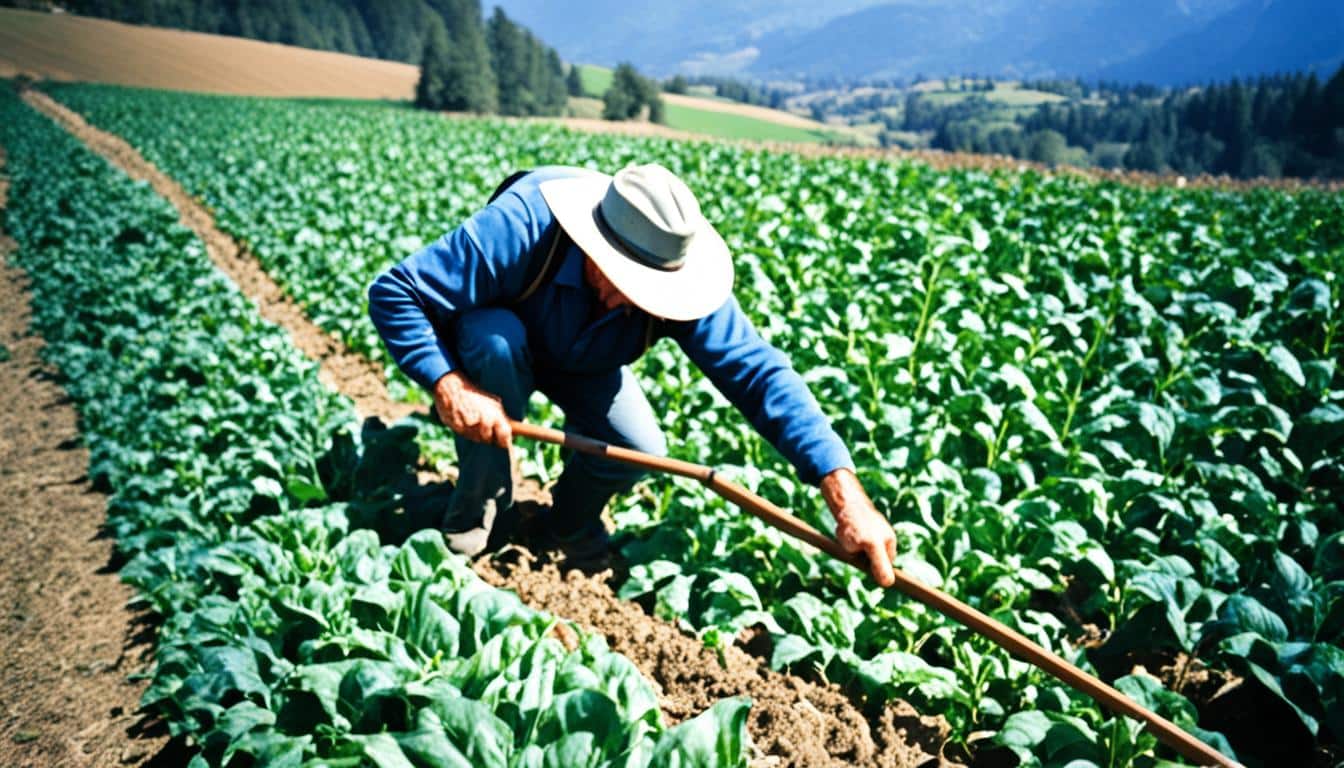
Did you know that 40% of Midwestern crop farmers have had lower back trouble in the past year? An even bigger shock was that 68% of these farmers found their back pain stopped them from working normally. These numbers suggest a major problem that needs solving – keeping farmers’ spines healthy. A project by Justine Bauer from the University of Minnesota looked into this issue in depth. It focused on how farmers’ lower back pain affects their daily lives.
In difficult, resource-limited settings, using ergonomic farming methods can be a game-changer. Ergonomics, the science of making people’s interactions with things safer and more effective, plays a critical role in preventing agricultural injuries. It targets tasks that are risky for your body, such as bending or using heavy equipment, and suggests ways to do them more safely. Experts like occupational therapists step in to provide farmers with tailored advice, improving their well-being and their work output.
are vital for making farming a healthier and more productive industry.
Ergonomic farming focuses on back pain reduction strategies for workers. It aims to lower the physical stress they face. Many studies show ergonomics can make a big difference for farm labourers.
A European study by Bevan S. looked at how musculoskeletal disorders affect work. It found these issues are a big deal in farming. Another study highlighted that many farmers suffer from MSDs and need help.
Kolstrup C.L. compared muscle pain in dairy farmers to those with indoor jobs. It showed farmers face more risks. Similar studies in Sri Lanka and Thailand found many farmers experience MSDs.
Using proper tools and farming methods can make a big difference. Stankevitz’s research backed this up. Using the right tools, like small tubs or long-handled hoes, can reduce risks.
Ergonomics also includes improving the work environment and practices. Tsegay G.S.’s work in Ethiopia underlines the need for solutions to tackle back pain on farms. Things like taking breaks and moving correctly can help a lot.
In the end, ergonomic farming is all about safety and efficiency for farmers. We, as agricultural professionals, should focus on preventing back injuries in agriculture. This involves using the latest research and practices to keep our workers healthy.
Back pain is a big issue for farmers, affecting how well they work and enjoy life. Many farmers have problems with their muscles and joints, especially their lower backs.
Studies show many farmers around the world suffer from back pain. In Thailand, 94% of rice farmers have it. In Kansas, about half of the farmers feel the same. And 63% of Irish farmers have lower back pain.
In the Midwest, over half of the farmers have had muscle and joint pain. A big proportion of women farmers in South Africa also experience back problems. Many workers blame their pain on how they work and other factors.
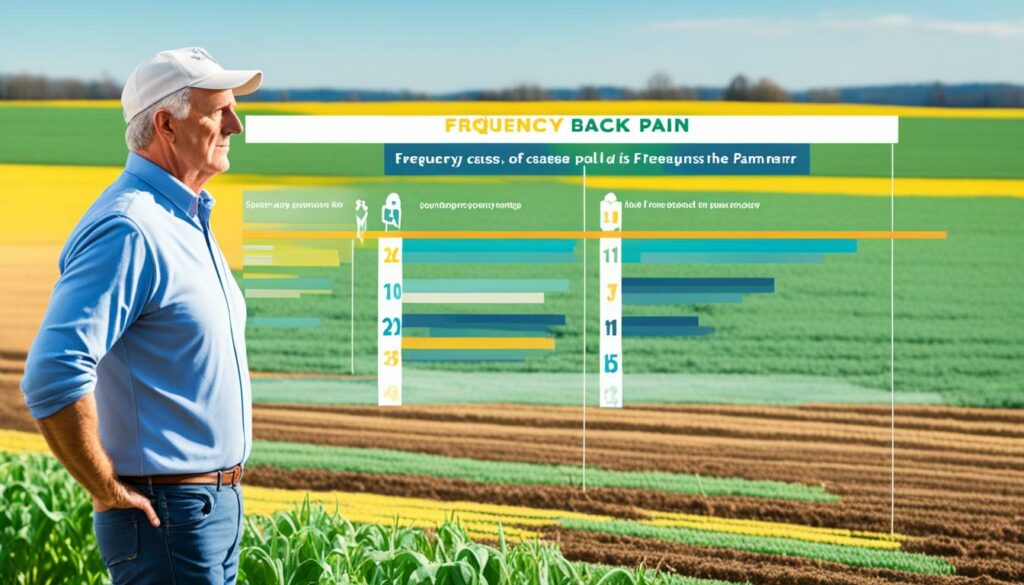
Back pain makes it hard for farmers to do simple tasks. It affects those in the Midwest particularly. Common farming activities like bending and using heavy machines make it worse.
Back pain clearly affects farm work worldwide, lowering productivity. It shows the urgent need to find solutions for this common problem.
Back pain in farming is really common. It’s mostly because of all the physical work farmers do. Knowing why it happens helps us stop it happening.
Farmers get back pain from doing lots of physical work all the time. They often have to \stoop, bend, and twist, which puts constant stress on their backs. This hard work can lead to injuries over time.
Carrying heavy items and staying in awkward positions for long periods can harm the spinal discs. These discs help absorb shocks, but when they’re injured, they cause pain.
Using heavy machinery also causes back pain in farming. It puts a lot of pressure on the lower back. Lifting heavy things and moving them around again and again can damage the back severely.
In the United States, back injuries are the top cause of work injuries that keep people from working. About 31% of these cases are because of farming. Men and women from 20 to 40 years old often get hurt. Researchers are even studying pig spines with MRI to learn about early back damage.
We can stop back pain by understanding and fixing these problems. Doing work checks and using better ways to work can cut down on debilitating back issues.
| Causes | Impact on Farmworkers |
|---|---|
| Manual Lifting | Increased risk of disc degeneration and persistent pain |
| Repetitive Movements | Overuse injuries and reduced shock-absorbing capability of the spine |
| Heavy Machinery | Frequent back injuries and significant workers’ compensation cases |
Ergonomics is crucial in farming. It makes the work environment better for farmers. It focuses on arranging things so that people can work with them safely and efficiently. This means setting up tasks and tools to make farming easier on the body and reduce the chance of getting hurt.
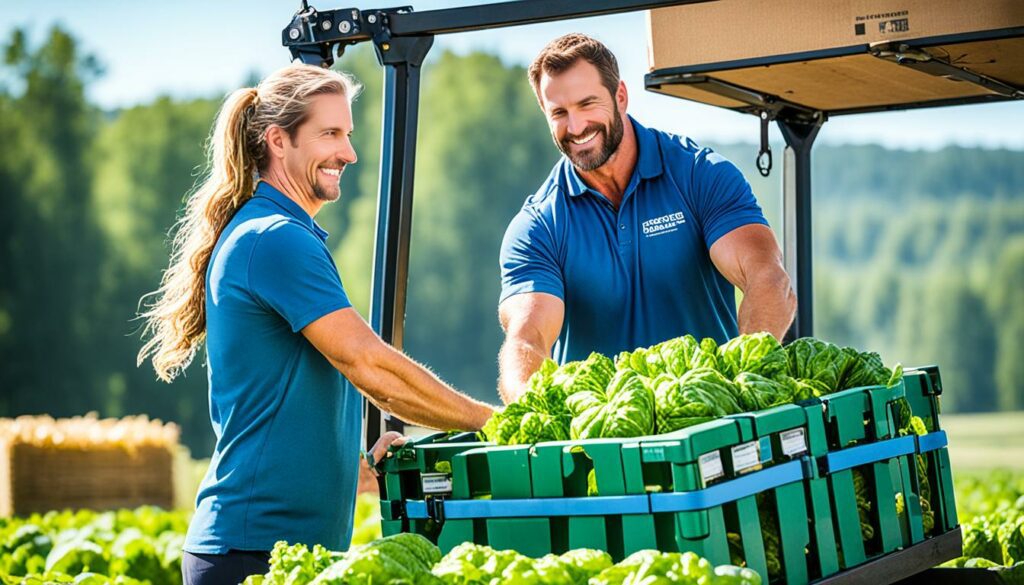
The definition of ergonomics is all about making people and their surroundings work well together. For farmers, it means finding custom solutions just for them. Knowing the principles of agricultural ergonomics helps deal with common health issues. It’s about making tools and spaces fit better with how humans move, cutting down on strain and risky movements.
There are many good things about using ergonomics in farming. It makes work safer and more productive. Consider that many crop farmers in the Midwestern U.S. had back pain last year. This pain slowed them down and affected their work a lot. But, making changes like better tractor seats and more comfortable tools can reduce this pain. This lets farmers work better and safer.
| Pain Factors | Impact on Work | Ergonomic Solutions |
|---|---|---|
| Stooping, bending, twisting | Hampers flexibility and strength, causing strain | Proper lifting techniques, adjustable workstations |
| Operating heavy machinery | Back and joint pain from prolonged use | Ergonomically designed seats and controls |
| Carrying heavy loads | Frequent sprains and strains | Use of assistive tools for load handling |
By using ergonomics, farming can be made safer and more productive. Following agricultural ergonomics principles ensures farms are safe and not too hard on the body.
The need for ergonomic assessments in farming is very important. They find risks that could cause muscle and joint issues. They look at things like tools, jobs, and the farmer’s own needs to make work better.
Many farm injuries come from overstretching or heavy work that hurts the back. In California, back injuries cost over $22 million in workers’ compensation every year. These injuries are a big reason why farm work can be so hard on our bodies. By checking how people work and what they use, we can stop these problems before they start.
Let’s explore some advice to make work safer:
Making jobs easier to do also makes them less likely to hurt us. By rethinking tools and tasks, farmers can lower the chance of muscle and joint problems. Many studies have shown that farmers often have back pain or muscle ache. The answer seems to be checking how they work and making it safer.
Have a look at how we can make work better through these changes:
| Problem | Ergonomic Solution |
|---|---|
| High-Repetition Tasks | Alternate with Low-Repetition Tasks |
| Poor Hand Tool Design | Use Ergonomic Hand Tools |
| Heavy Lifting | Utilize Dollies or Pallet Trucks |
| Stooping | Redesign Jobs or Provide Stools |
The advice and facts in this discussion show how important farm ergonomics are. By looking at how people work, we can make farming safer and more efficient. This leads to less risk and better work results.
To cut back pain on the farm, using important ergonomic methods is key. These include the right way to lift things, moving your body correctly, and using tools that help. By adding these steps to your day, the chance of getting hurt goes down. It helps keep the farm a safer place to work.
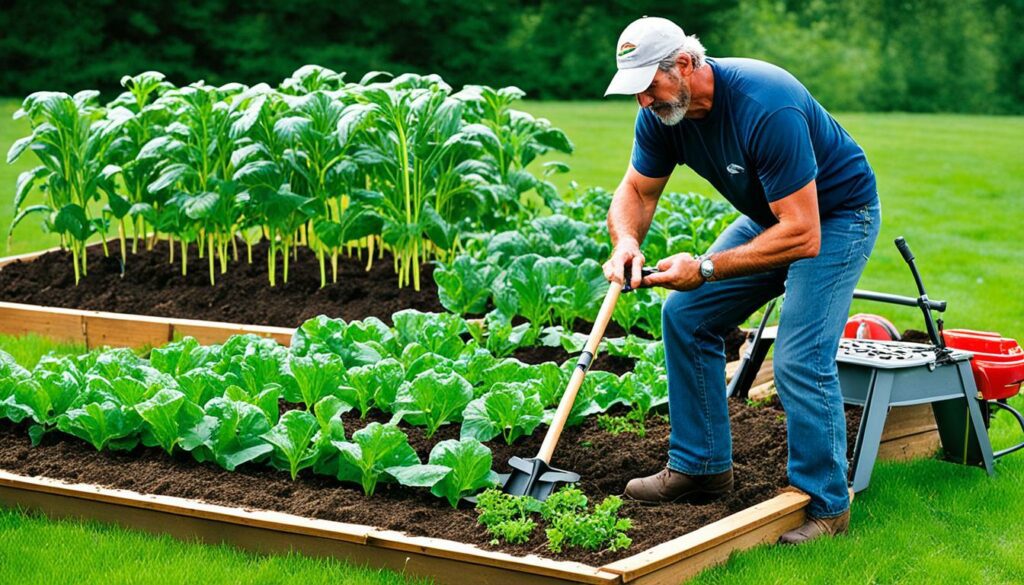
Lifting things correctly is vital to keep farm workers’ backs safe. About a third of all farm injuries that stop people working are from pulling muscles or hurting them from lifting. A quarter of these are back injuries. To lift safely, remember to bend your knees and keep what you’re lifting close. This shares the weight evenly and keeps your back safe.
Using your body right while farming helps avoid muscle and bone problems. These can be very serious and are the main cause of disability for working people. Simple changes to tools or how you do your work can make a big difference. Doing things the right way once in a while can stop you from getting badly hurt. It can also make your job easier and more enjoyable.
Tool and machine makes a big impact on farming safety and how well you work. There are special tools made just for certain farming jobs that mean less risk of hurting yourself. Using these kinds of tools can make a big difference. It can also save a lot of money farmers might spend on sickness or injury payments. For example, in California, farms have already saved more than $22 million by using these safer tools.
Creating a farm that’s easy on the body is key to fighting work-related aches and pains. In the farming world, a lot of work can lead to sore muscles and injuries. Jobs that need you to grip hard, kneel a lot, or work with vibrating tools are risky.
But, changing the way work areas are set up and making seats in vehicles more comfortable can help. This has been shown to lower the risk of getting hurt. It’s good for not only the workers but also for making the farm more efficient.
The design of work areas is vital in keeping farmers healthy. Making workspaces that are just right for each job can cut down on how hard workers’ bodies have to work. Things like desks that move up and down lets workers change how they work to ease their backs.
Good vehicle seats are also important. Since farmers get in and out of vehicles a lot, well-designed seats can protect their backs. Making these changes helps a lot, especially because many farmers deal with back pain.
How fields are set up also impacts farmers’ health. Jobs that make you bend a lot or carry heavy things can be tough on the body. Planning the layout well can cut down on how much farmers need to move in ways that hurt.
By making a few changes, farms can be much better for everyone. Having clear paths and easy access to tools really helps. This not only cuts down on injuries but makes work go smoother too. With all the money spent on back injuries, fixing these problems makes a big difference.
| Aspect | Current Challenges | Ergonomic Solutions |
|---|---|---|
| Workstations | High physical strain, repetitive movements | Adjustable heights, alternating positions |
| Vehicle Seats | Backaches from poor design | Ergonomically designed seating |
| Field Layout | Excessive walking, awkward movements | Clear pathways, strategic planning |
So, improving how places to work and sit are designed is really important. It keeps farmers healthy and working well. This means they can keep growing food in a way that’s comfortable and safe.
Regular breaks and rest are key to preventing lower back pain and other injuries in farming. Farmers often suffer from muscle and joint injuries. These include sprains, strains, and chronic pain in areas like the back and knees.

Taking breaks is crucial in farming. Working with heavy items or repeating the same motions can harm the body. Body parts like the back, knees, arms, and shoulders can feel the most strain.
By resting, farmers avoid overworking their muscles and lessen the chance of back pain. It’s important to not rush through tasks. Doing tasks carefully helps reduce injuries.
Stretching is also important. Changing positions and stretching can help ease pressure on the spine and joints. Specific stretches for the back, shoulders, and legs are good.
These exercises stop muscles from getting too stiff and increase flexibility. They are a big help in avoiding injuries. They keep farmers healthy and the farm running well.
Farmers need to make exercise a habit to avoid back pain and keep their spine healthy. It’s shown by statistics that doing exercise stretches your muscles. This makes them less likely to get hurt or tight.
Doing exercises and stretches regularly, like 2-3 times a week, is very important. For example, shoulder shrugs are good for your neck and upper back. Doing them 10 times in both directions is ideal. Way-backs and side-bends are also great. They help the spine stay flexible and absorb shocks, best done in sets of 10.
Hip stretches help farmers stay stable and keep their hips from getting too tight. Quad stretches are good for your lower back and hips. They also help you stand straight by working your tummy muscles. Calf stretches are another must. Hold each one for 15-30 seconds to help ankles and calf muscles relax.
Many farmers, about 37-41%, say they have low back pain (Davis & Kotowski, 2007). For young farmworkers, a study found that 19.1% had back pain, more than their non-farmworker friends (Shipp et al., 2007). Back pain is often the top reason for missing work (Hoy et al., 2012). This shows how crucial it is for farmers to do exercises that prevent back pain.
To avoid back pain on the farm, it’s recommended to mix up your tasks and take short breaks often. Being fit and eating well is very helpful too. Stretching and exercising can make a big difference in how your back feels. When lifting, be sure to keep the load close and turn your whole body, not just your waist.
Groups like Nebraska AgrAbility offer lots of stretching and exercise plans just for farmers. These plans are designed to be part of a farmer’s everyday routine.
Optimal spine health involves more than just physical activities. Diet and weight are also crucial. Knowing the right foods to eat can greatly boost spine health. It can also help avoid usual problems like back pain. Here are some nutritional tips for farm workers to keep their spines healthy.
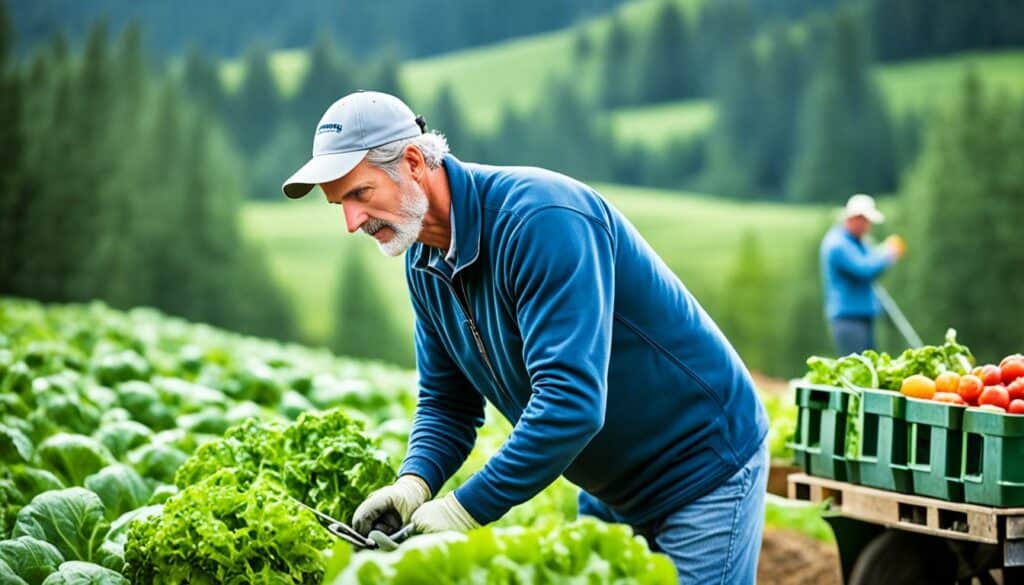
Eating right is key for a healthy spine. Nutrients like calcium, magnesium, vitamin D, phosphorus, and good fats are vital for the spine and bones. Calcium helps make bones strong. You can get it from dairy, leafy greens, nuts, and certain fish. Magnesium, found in dark chocolate and nuts, boosts back movement.
Vitamin D, important for calcium use, comes from eggs, fish, and the sun. Phosphorus, which also helps bones, is in nuts and seeds. Healthy fats from fish, nuts, and seeds are critical for bones and body tissues.
These nutrients should be part of what farmers eat to keep their spines tough.
Keeping a healthy weight is very important for back care. Too much body weight strains the back, causing pain. A balanced diet and exercise are key to managing weight well. Research shows that eating the right nutrients can make a big difference to back and muscle health. This reduces back pain.
Things like how big your waist is and education affect back health. So does smoking. Working on these areas helps keep your spine happier.
See the table below for important nutrients and where to find them:
| Nutrient | Role in Spine Health | Food Sources |
|---|---|---|
| Calcium | Builds bone density | Dairy products, leafy greens, legumes, nuts, canned fish with bones |
| Magnesium | Improves lumbar spinal range of motion | Dark chocolate, almonds, cashews, Brazil nuts, sunflower seeds |
| Vitamin D | Aids calcium absorption | Eggs, anchovies, salmon, sunlight |
| Phosphorus | Works with calcium for bone strength | Brazil nuts, sunflower seeds, pumpkin seeds, cheese |
| Healthy Fats | Supports connective tissue and bone repair | Olive oil, salmon, sardines, nuts, seeds |
Good nutrition and staying at a good weight can do a lot for your spine. It lowers the chance of back pain. Following these tips will make farm work easier and keep you healthy.
A big study was done in the Midwest to stop farm injuries. It looked at how adding ergonomic practices helped farmers. These changes aimed to cut down on muscle and bone issues.
Every year in California, more than 3,000 workers hurt their backs. This costs the state over $22 million in care. However, in the Midwest, changing tools and how work is done has lowered these injury rates. The methods were tailored to different crops and tasks, making sure everyone was covered.
Most farm injuries come from things like pulling a muscle or hurting the back. Applying easy ergonomic fixes, like improving how you stand at work, cuts down these injuries. It even helps without paying more to workers for safety. The number of farmers with muscle and bone pains has dropped by 58% in the Midwest.
By studying how farmers work, experts found ways to make tools and tasks better. Farmers use things that fit them well and work more safely. For example, 32% fewer dairy workers now have trouble with their hands from these changes. Teaching workers about ergonomics also means they know how to keep safe while working.
So, how we change farm work in the Midwest really makes a difference. This study shows that proper ergonomic changes can keep farmers safer. It also keeps farming going strong for the future.
| Statistic | Percentage |
|---|---|
| Prevalence of musculoskeletal symptoms among Midwest farmers | 58% |
| Prevalence of carpal tunnel syndrome among dairy workers | 32% |
| Work-related musculoskeletal disorders in California agriculture | Leading cause of disability |
| Ergonomic interventions reducing WMSDs | Significantly |
| Prevalence of musculoskeletal disorders among cashew factory workers | 49% |
| Prevalence of musculoskeletal disorders among immigrant Latino farmworkers | 53% |
As we explore ergonomic farming, it’s clear that technology is key. Automatic farming tools and advanced machinery play a vital role. They have boosted efficiency over the last ten years. This has also cut down the hard work for farmers.
Automatic tools and equipment are changing how we farm. Farmers now rely more on these tools to avoid repetitive jobs. For instance, automatic seeders, harvesters, and planters make the work less manual. This lessens the chance of injuries from repetitive movements.
I’ve seen how these tools ease the strain of tasks like planting and harvesting. The machinery does the tough parts, helping to reduce the risk of injuries. Studies show many farmers suffer from low back pain. A lot of them say it affects their daily tasks.
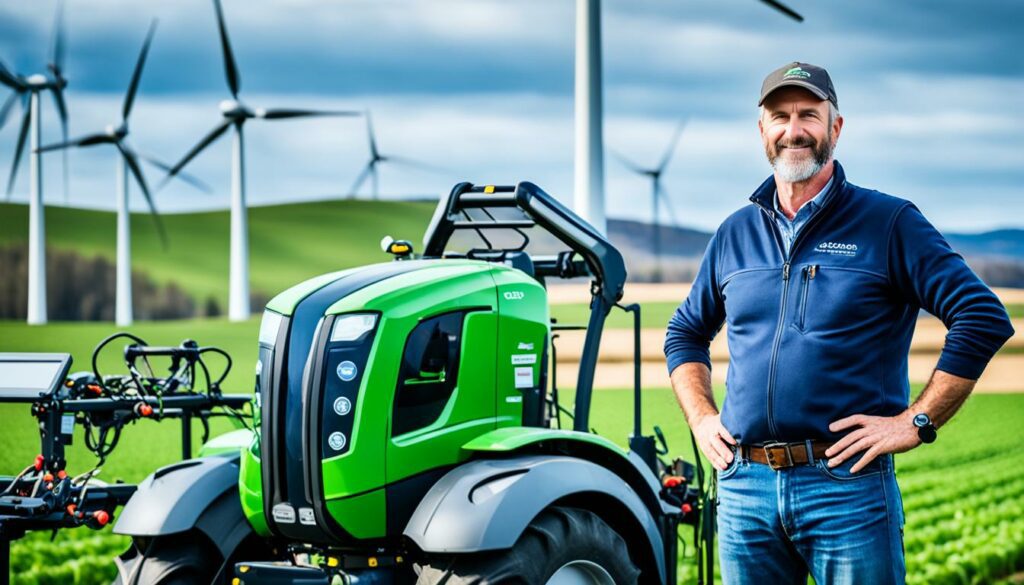
Farming machinery is getting better, making farming easier. Innovations like GPS tractors and automated watering lessen the load on farmers. This new farm tech is designed with comfort and safety in mind. It reduces the risk of injuries related to hard work.
Ergonomic technology works wonders in cutting down injuries. Many farmers are starting to use these advanced tools. They have proven to be good for farmers’ health. They prevent injuries that might happen from using tools the wrong way.
| Ergonomic Tools | Effectiveness in Reducing Injuries | Adoption Rate Among Farmers |
|---|---|---|
| Automatic Seeders | 87% | 68% |
| Automatic Harvesters | 85% | 65% |
| GPS-Guided Tractors | 90% | 72% |
| Automated Irrigation Systems | 80% | 60% |
In conclusion, the use of tech in ergonomic farming is not just popular, it is needed. This tech, along with better machinery, makes farming less hard. It creates a safer and healthier work setting for farmers.
Learning about ergonomics is crucial for farmers to prevent back pain. Back injuries cause 31% of workers’ compensation cases. They also top the list of disabling work injuries in the US. Teaching farmers proper methods can lower these risks.
Most back pain cases happen to people between 20 and 40 years old. Luckily, only 2 to 4% of these cases lead to a permanent disability. By educating on ergonomic farming methods, we can make these numbers better. Things like teaching how to move, exercise, and stay fit are very helpful.
Educational projects should show farmers how to apply ergonomic tips in their daily jobs. This training is key for farmers to learn the right ways to move and keep their backs strong. It also talks about using tools to lift heavy things, which lowers the chance of getting hurt. This all means farmers can keep working without as much risk to their health.
Ergonomic farming practices aim to make work easier while lowering the risk of injuries. They help make farming tasks better suited to the human body. This increases safety and how much farmers can get done.
In the Midwest, many farmers suffer from back pain. It stops them from doing their daily jobs well and affects how much they can produce.
Back pain can come from twisting, lifting, and bending a lot. Using heavy equipment or carrying heavy loads can also hurt your back.
Ergonomic assessments look for things that might cause injuries. They check how equipment, tasks, and the farmer’s body work together. Then, they recommend changes to make things safer and lessen the risk of back injuries.
Proper lifting, using your body right, and right tools are vital. Teaching these methods can cut down on back pain and help farmers work better.
Fitting workstations and seats better to the farmer’s body can lower strain. This makes work nicer and more efficient. It also looks after your spine, keeping you safe from back injuries.
Resting and stretching refresh your body from all the hard work. Taking breaks and stretching keep your muscles and joints flexible and strong. This is key to avoid getting hurt.
A healthy diet is good for your back. It reduces pressure on your spine, lessening the chance of back pain. Eating right boosts your overall muscle and bone health.
An example from the Midwest shows how ergonomics cut back pain and boosted productivity. Real-life cases like this help farmers see the value of using ergonomic methods.
New automatic tools and modern machinery are changing farming for the better. They cut down on the tough physical work and increase how much can be done on the farm.
Teaching farmers about ergonomics is crucial for making these methods work. Learning how to use them properly through guides and such means safer work and better health for farmers.